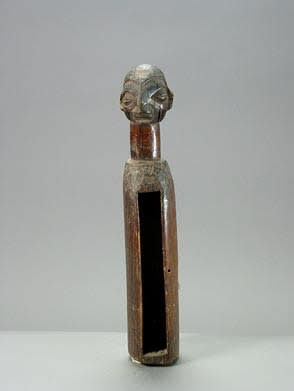Luba Wooden Slit Gong, 20th Century CE
Wood
3.25 x 18.5
PF.6001
Further images
The slit gong is defined as a hollowed tubular piece of wood with a longitudinal slit on one side. The tube is beaten at the edges of the slit. One...
The slit gong is defined as a hollowed tubular piece of wood with a longitudinal slit on one side. The tube is beaten at the edges of the slit. One lip is carved thicker than the other so as to produce two or more pitches when banged. The instrument is unique because the whole instrument sounds when beaten, without any attachments of other materials such as metal or strings to create the sound. This wood gong is anthropomorphic featuring a highly stylized face crowning the handle. The facial features of this charming head are unusual for the Luba style. Perhaps the artist has tried to represent a specific individual and not an idealized representation of an ancestral spirit. Might this man portray the player of this instrument? Traditionally, wood gongs are traditionally made from mahogany or ebony; the higher the quality of wood, the crisper the sound that is produced. Gongs are used in ceremonial orchestras as background rhythm and often follow the beat of the master drummer during these performances. The sound produced by this gong is but a piece of the larger symphony of Luba ceremonies. Combined with blaring drums, ringing bells, and flailing dancer, the effect would be truly intoxicating.





